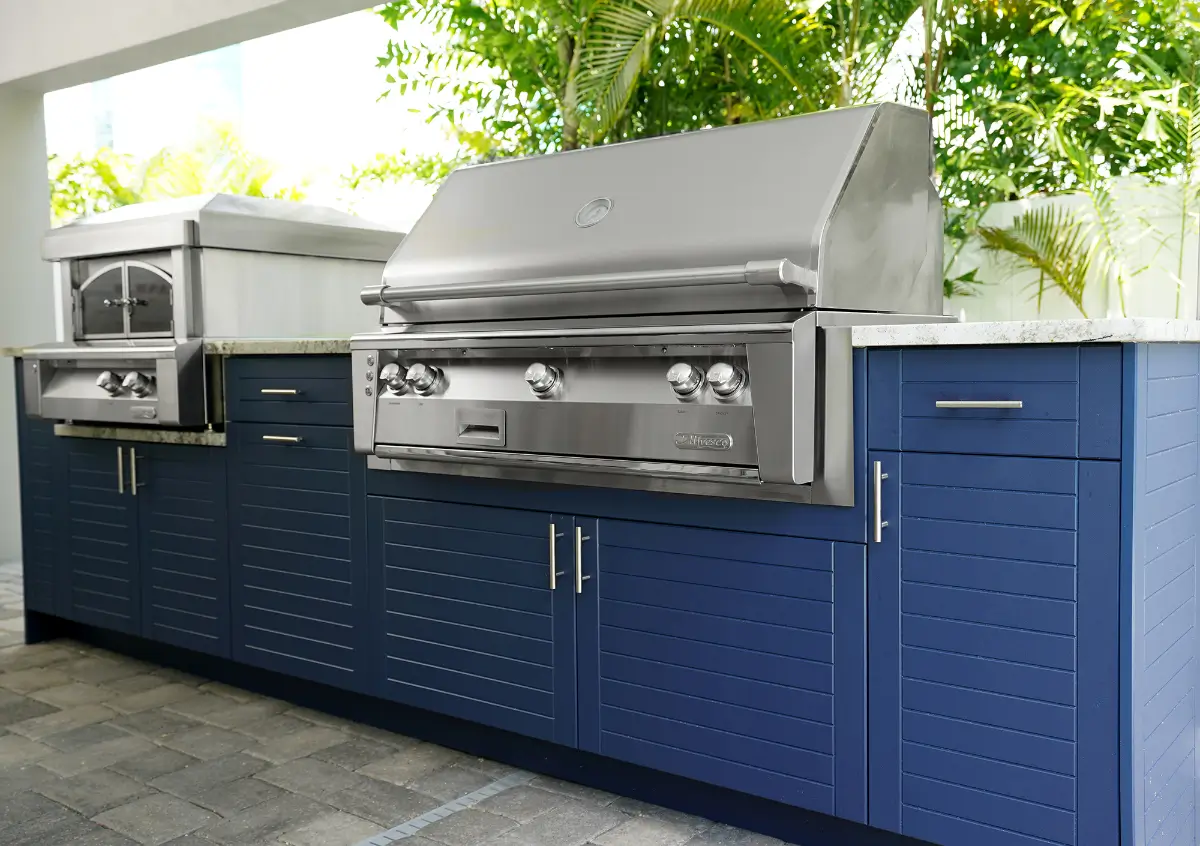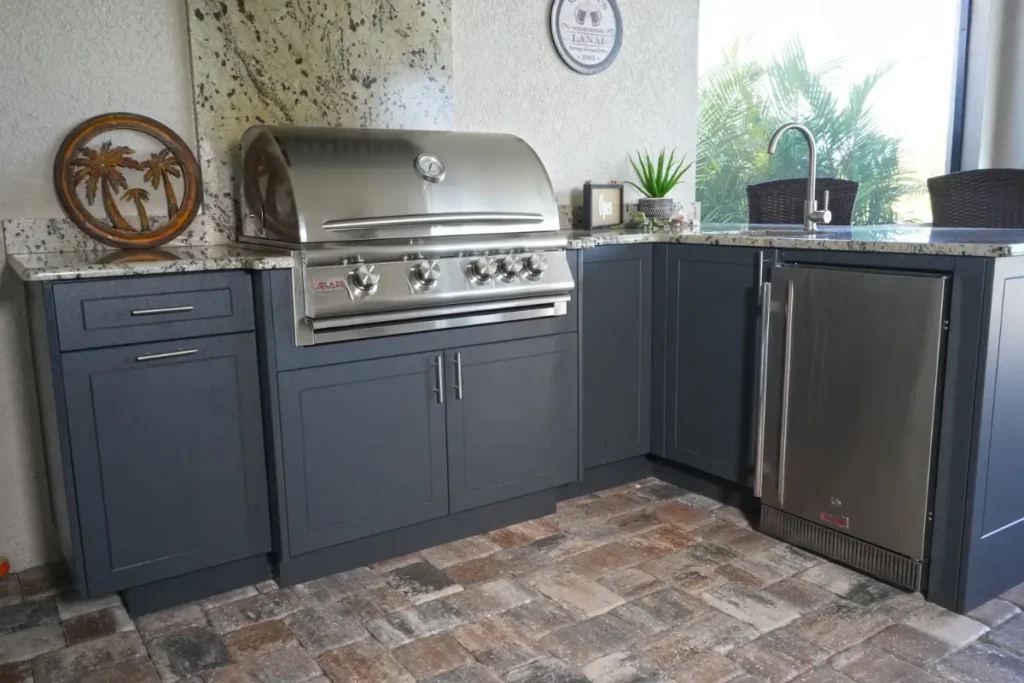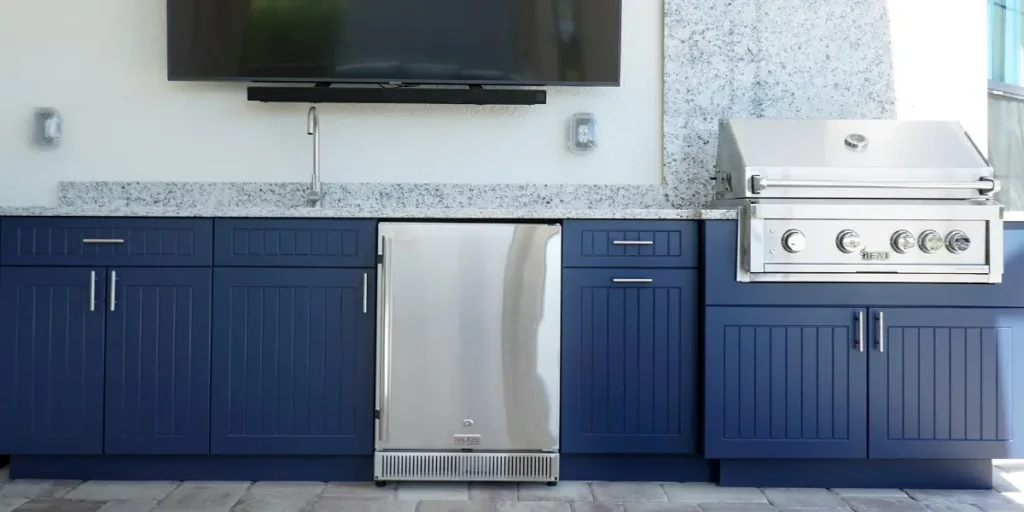
Electric Grills vs. Gas Grills: Which Is Best for Your Outdoor Kitchen?
Choosing between electric grills vs. gas grills for your outdoor kitchen can be a tough call. Both have advantages, and the right choice depends on your cooking style, convenience preferences, and the setup of your outdoor space. Whether you’re designing a fully equipped outdoor kitchen or upgrading your grilling setup, understanding the key differences between these two options will help you make the best decision.
Table of Contents
How Electric and Gas Grills Work
Electric Grills
Electric grills use heating elements powered by electricity to cook food. Unlike gas or charcoal grills, they don’t produce an open flame. Instead, the heat comes from coils that evenly distribute warmth across the cooking surface. Many electric grills feature adjustable temperature controls, making it easy to maintain consistent heat.
Gas Grills
Gas grills use propane or natural gas to generate an open flame beneath the grates. They offer quick heat-up times, adjustable flame control, and the ability to cook at high temperatures. Most gas grills include multiple burners, allowing for direct and indirect cooking methods.
Performance and Cooking Experience
Heat and Temperature Control
Gas grills generally provide higher heat output than electric grills, making them better suited for searing steaks and other meats that require intense heat. Many high-end gas grills can reach temperatures above 600°F, giving food a crisp, flavorful exterior.
Electric grills, on the other hand, tend to max out around 500°F. While this is sufficient for most grilling needs, it may not deliver the same level of char or sear that a gas grill can achieve. However, electric grills excel at maintaining consistent temperatures, which is useful for grilling delicate foods like fish and vegetables.
Flavor and Smoke Production
One of the biggest advantages of gas grills is their ability to create a rich, smoky flavor. Because they produce an open flame, they allow drippings from food to vaporize, infusing your meals with that classic grilled taste. Many gas grills also come with built-in smoker boxes or flavorizer bars that enhance smokiness.
Electric grills do not generate smoke in the same way, which means food lacks that traditional grilled flavor. Some models offer features like smoke trays or wood chip compartments, but they don’t replicate the depth of flavor that a gas grill provides.
Cooking Versatility
Gas grills offer more versatility in cooking styles. With multiple burners, you can create different heat zones for direct and indirect cooking. This allows you to sear a steak on high heat while slow-cooking ribs on a lower setting.

Electric grills are more limited in this regard. They provide even heat across the cooking surface but do not have separate zones for different temperature settings. However, their precise temperature control makes them excellent for certain techniques, such as low-and-slow grilling.
Convenience and Ease of Use
Startup and Preheating
Electric grills are incredibly convenient to start. Just plug them in, turn the dial, and they’re ready to heat up. Preheating usually takes around 10-15 minutes, depending on the model.
Gas grills require a bit more effort. If you’re using propane, you’ll need to check your fuel levels and ensure the tank is properly connected. If your grill runs on natural gas, you’ll need a dedicated gas line installed. Once ignited, gas grills preheat quickly, usually within 5-10 minutes.
Cleaning and Maintenance
Electric grills are easier to clean since they don’t produce ash or grease flare-ups. Most have removable grates and drip trays that can be cleaned with soap and water. Some models even feature non-stick surfaces that reduce residue buildup.
Gas grills require more maintenance. Burners need occasional cleaning to prevent clogging, and grease traps must be emptied regularly. Over time, gas grills can accumulate carbon buildup, requiring deep cleaning to maintain performance.
Safety Considerations
Electric grills are generally safer than gas grills because they do not have an open flame. This makes them ideal for covered patios, balconies, and areas where fire hazards are a concern.
Gas grills require proper ventilation and safe handling of propane tanks or gas lines. They should not be used in enclosed spaces, as gas leaks can be dangerous. Additionally, gas grills are more prone to flare-ups if grease drips onto the burners.
Cost Considerations
Initial Cost
Electric grills are typically more affordable than gas grills. Entry-level models start around $100, while high-end electric grills can range from $500 to $1,500, depending on features and size.
Gas grills vary widely in price. Small, portable models start around $150, while mid-range grills range from $500 to $2,000. Premium outdoor gas grills with built-in features, high BTU output, and stainless steel construction can cost $3,000 or more.
Operating Costs
Electric grills are more energy-efficient than gas grills, but they do require a reliable power source. The cost of electricity varies by location, but in most cases, running an electric grill is relatively inexpensive.

Gas grills have ongoing fuel costs. A standard 20-pound propane tank costs around $20 to refill and lasts for 18-20 hours of grilling. Natural gas is more cost-effective in the long run, but installation costs for a gas line can be high.
Outdoor Kitchen Integration
Space Requirements
Electric grills are ideal for small outdoor kitchens, patios, and balconies where space is limited. They don’t require venting or special clearances, making them a good option for covered areas.
Gas grills need adequate ventilation and clearance from walls or ceilings. If you’re designing a built-in outdoor kitchen, a gas grill may require a dedicated gas line, which adds to installation costs.
Weather Resistance
Electric grills are more affected by weather conditions than gas grills. Exposure to rain, extreme heat, or humidity can damage electrical components. If you plan to use an electric grill in an uncovered outdoor kitchen, a weatherproof cover is essential.
Gas grills are more durable and can withstand outdoor conditions better. High-quality stainless steel models are resistant to rust and corrosion, making them ideal for permanent outdoor setups.
Which One Should You Choose?
Choose an Electric Grill If:
- You need a grill for a covered patio or small space where open flames are restricted.
- Convenience and ease of use are top priorities.
- You prefer steady, even heat with minimal maintenance.
- You don’t need the high temperatures required for heavy searing.
Choose a Gas Grill If:
- You want an authentic grilled flavor with smoke and char.
- High heat and adjustable temperature zones are important.
- You have space for a permanent outdoor kitchen setup.
- You’re comfortable with fuel management and maintenance.
Both electric and gas grills have their place in an outdoor kitchen. If you value convenience and safety, an electric grill might be the better option. If you’re after the full grilling experience with flames, smoke, and high heat, a gas grill is the way to go. Think about how often you grill, what types of food you cook, and the space you have available before making your choice. Whichever grill you pick, investing in a quality model will enhance your outdoor cooking experience for years to come.
